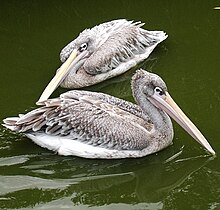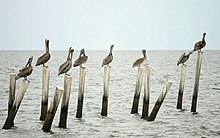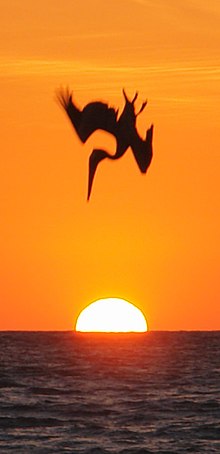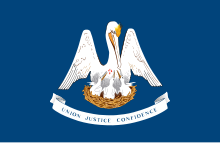Pelicans
| Pelicans | ||||||||||
|---|---|---|---|---|---|---|---|---|---|---|

Brown pelican ( Pelecanus occidentalis ) |
||||||||||
| Systematics | ||||||||||
|
||||||||||
| Scientific name of the family | ||||||||||
| Pelecanidae | ||||||||||
| Rafinesque , 1815 | ||||||||||
| Scientific name of the genus | ||||||||||
| Pelecanus | ||||||||||
| Linnaeus , 1758 |

The pelicans (Pelecanidae, Pelecanus ) are a family and genus of waterfowl and namesake of the order Pelecaniformes . Except for Antarctica, they are represented on all continents. Their shape and above all their very elastic skin sac on the lower beak make them unmistakable.
features
Pelicans are large to very large water birds. The Dalmatian pelican , the largest species of the genus, can reach a body length of 1.80 m, a wingspan of 3.45 m and a weight of 13 kg. This makes it one of the largest and heaviest birds capable of flying. As the smallest species, the brown pelican has a wingspan of 2 m and a weight of 4 kg. The skeleton of the heaviest pelicans only makes up about 7% of the body weight.
The most noticeable feature of the pelicans is their 25 to 47 cm long beak . The throat pouch, which is present in almost all rowefooters, is extremely enlarged in them and connected to the lower beak, from which it hangs down as an extraordinarily flexible skin pouch. This throat pouch, the capacity of which can be up to 13 l in the largest species, is used as a landing net when fishing ; it is tightly closed by the long, slightly downwardly curved upper beak.
The wings are long and wide. Of the eleven hand wings, one of which is usually greatly reduced, the outermost five to seven are deeply fingered, which makes pelicans excellent thermal sailors. The weight makes lifting a strenuous affair. A pelican has to walk a long distance, flapping its wings, on the surface of the water before it can rise into the air. But if it took off successfully, it is a persistent flier. Pelicans can fly 24 hours without a break and cover up to 500 km; the flight speed can be 56 km / h, the flight altitude over 3000 m. In flight, pelicans bend their necks back so that the head lies between the shoulders and the heavy beak can be supported by the neck. Since the muscles do not allow constant wing flapping, long gliding phases alternate with wing flapping. For this purpose, the thermals are used that carry the bird into the air and enable it to fly in an energy-saving manner.
As with all rowefooters, all four toes are webbed. The legs are wide apart and quite far back on the body. They are suitable for providing a powerful drive when swimming, but on land only allow sluggish, waddling locomotion.
The plumage of the pelicans is almost always colored white, with black areas on the wings. An exception is the brown pelican, whose basic color reveals its name. The white pelicans sometimes have a pink or gray tinted plumage; this hue comes about through a secretion of the root gland . How strong the color is depends on the regional food options. Pelicans have featherless areas on their faces that can take on bright colors during the breeding season. Often this color enables the differentiation of the sexes ( gender dimorphism ). The strong colors usually only exist for a few days before they fade again. The rhinoceros pelican also has a special characteristic, which has a hump on its upper beak during the breeding season that can reach a height of 7 cm; after the end of the breeding season, the hump is thrown off.
distribution and habitat

Pelicans inhabit tropical, subtropical and temperate zones. In Europe there are deposits in the Balkans, with the colonies of the pink and Dalmatian pelicans in the Danube Delta being the best known. There are also occurrences of these two species on Lake Prespa and on the east coast of the Sea of Azov . The Dalmatian pelican occurs in some colonies on the lower reaches of the Volga and on the north coast of the Caspian Sea . These two species as well as the gray pelican are also found in West and Central Asia. The latter also in South Asia. Africa is home to the red chalk pelican, which inhabits tropical and subtropical regions there; The breeding and winter quarters of the Great White Pelican, whose distribution extends from the Sahel to South Africa, are further extended. The African pelican lives in Australia and Tasmania and is regularly found in New Guinea , the Solomon Islands and the Lesser Sunda Islands outside of the breeding season . The rhinoceros pelican breeds in the Midwest of North America , northward to southern Canada; he winters on the coasts of North and Central America. The coasts of the American double continent are home to the brown pelican.
In winter, some species can also endure extreme cold, but need ice-free waters. Most species prefer fresh water. Since they require large amounts of fish for food, they are found on large lakes or in river deltas, and because they do not dive deep, shallow water is a requirement. This is the reason why pelicans are almost absent on deep lakes like Lake Malawi , but are extremely common on shallow lakes not far away like Lake Nakuru .
Several species can also be found in brackish water, and some are found on coasts to winter. The brown pelican is the only species that lives all year round and exclusively by the sea.
Most pelicans are resident birds or short-range migrants ; this applies to the tropical species, but also to the Dalmatian pelicans of the Danube Delta . In contrast, the great white pelicans of the Danube Delta migrate long distances and migrate to African wintering areas after the breeding season. They pause for two to three days in Israel , where the birds are given tons of fresh fish.
Way of life
nutrition

The diet of the pelicans consists almost exclusively of fish. There are only a few exceptions: the rhinoceros pelicans have occasionally been seen eating tailed amphibians and crayfish , and the pelican also feeds on crustaceans . In rare cases, pelicans also devour whole birds. In one case, a spectacled pelican is said to have eaten a white-throated duck and its young. In other cases, pelicans have eaten whole pigeons.
In the Danube Delta, carp , bitterlings and perch are the most important prey fish of the native pelican species (Dalmatian and white pelican). In North America, the rhinoceros pelican mainly eats carp of various species, mostly those that are meaningless to the commercial fishing industry. In Africa the pelicans there hunt mainly for cichlids of the genera Oreochromis , Tilapia and Haplochromis . Off the coast of Florida , the brown pelican mainly eats menhaden , an economically insignificant herring fish, but also anchovies and Pacific sardines off the South American coasts .
A pelican typically eats ten percent of its body weight a day. This is around 1.2 kg for the Great White Pelican. If this is extrapolated, the entire pelican population of the African Nakuru lake eats 12,000 kg of fish per day or 4,380 tons of fish per year.
The different species use different hunting methods, but they all hunt mostly in groups. The most widespread method is to build a horseshoe formation while swimming and thus drive the fish into shallower water, where they can no longer escape into the depths and can therefore be easily captured. Sometimes these actions are supported by violent flapping of the wings on the surface of the water. Other variants are to form a circle and close it, or two straight lines that swim towards each other. The pelicans plow through the water with their huge beak and catch the fish they have rounded up; the success rate for the great white pelican is 20%. After a successful catch, the water is let out of the skin sac and the fish is then swallowed. Hunting pelicans in groups is one of the few examples of coordinated foraging among birds.
All species can fish alone, and some prefer to do so, but all of them have the techniques described above or variations thereof. In contrast, only brown and chile pelicans hunt , which are shock divers . They also hunt fish at greater depths by swooping down vertically from heights of 10 to 20 meters.
Reproduction
Pelicans breed in colonies, with the ground-nesters forming larger and denser colonies than the tree-nesters. Mixed colonies often develop: In the Danube Delta, pink and Dalmatian pelicans often breed together; the tree-breeding species nest next to storks and cormorants , the brown pelicans next to guanot boobies and guanocormorants . In the past, pelican colonies numbered millions, the largest pelican colony today is that on Lake Rukwa in Tanzania with 40,000 pairs.
In temperate latitudes, the breeding season begins in spring, for European and North American species around April. In tropical climates, there are usually no fixed breeding seasons, and breeding can take place all year round.
During courtship , the bare skin areas on the face take on bright colors. The male pelicans perform a courtship ritual that differs from species to species, but often includes raising the head and beak and inflating the skin sac on the lower beak like a balloon. After the pair has found each other, the female (the male in the brown pelican) looks for a nesting site. Then the nest building begins, which in turn varies greatly from species to species. The ground-breeding species often only lay out a hollow, which they fill with little or no material such as grasses and twigs. Of course, the nests of the tree-breeding species are more elaborately designed. The gray pelican breeds mainly on mango trees , figs , palmyra palms or coconut palms . Building material is brought by the male in his beak sac. The nest consists of twigs and is covered with grass or rotting water plants; it has a diameter of about 75 cm and a height of 30 cm. The stability of the nest is often poor, so that a new nest has to be built every year.
Usually two eggs are laid, clutches with only one and up to six eggs occur. Both sexes breed, the total incubation period is 30 to 36 days. The young birds are initially naked, but after a few days they develop a white or brown downy dress, depending on the species. At the age of eight weeks, the down dress is replaced by the youth's plumage. Initially, the young are fed with a gagged food pulp. All young birds rarely get through. Often the first hatched young turns out to be the stronger one, which forces its siblings out of the nest or lets the others starve to death by consuming the food alone. At the age of 70 to 85 days, the young become independent and leave the parents either immediately or after a period of up to 20 days, during which they are still on the road with the parent birds.
Pelicans first breed when they are three or four years old. In Zoo pelicans reach an age of over 40 years on a regular basis; a spectacled pelican even lived to be 60 years old. In the wild, the maximum age is 26.5 years; they were found in a rhinoceros pelican.
Tribal history
The age of pelicans in their tribal history is controversial. From the Eocene is Protopelicanus cuvieri known, which was first described as a typical Pelikan. More recently, however, this has been denied. According to Harrison, the remains indicate a fossil gannet, according to Olson, a representative of the extinct Pelagornithidae. According to this, it is indeed a pelican, but probably not a real pelican.
The oldest undoubtedly pelican comes from the Miocene of France and is called Pelecanus gracilis (sometimes in its own genus Miopelecanus ). Shortly afterwards, Pelecanus intermedius appeared, a fossil pelican often found in Germany, and the small Pelecanus tirarensis in Australia. In the Pliocene there were many more species, including the rhinoceros pelican, a recent species, and the remains of several recent species can be found in the Pleistocene . The Dalmatian Pelican was widespread in Western Europe during the Pleistocene. The New Zealand pelican has occasionally been described as a historically extinct species, but is likely identical to the African pelican.
Systematics
The pelicans are the namesake of the order Pelecaniformes , which in addition to the pelicans also includes the shoebill ( Balaeniceps rex ), the hammer head ( Scopus umbretta ) as well as the herons (Ardeidae) and the ibises and spoonbills (Threskiornithidae).
Until a few years ago the order had an almost completely different composition and in addition to the pelicans, the gannets (Sulidae), the frigate birds (Fregatidae), the tropical birds (Phaethontidae), the cormorants (Phalacrocoracidae) and the darter (Anhingidae) were placed in the Pelecaniformes , while the shoebill, the hammer head, as well as the herons and the ibises and spoonbills belonged to the walking birds (Ciconiiformes). In this composition, the Pelecaniformes were called in the German rudder , after the structure of the feet, in which all four toes are connected by a web of webs. However, the similarities between pelicans and the other copepods families are based solely on convergence . Molecular biological findings ( DNA comparisons of mitochondrial DNA (mtDNA) and nuclear DNA ( nuclear DNA)) clearly speak against a relationship. In order to get back to monophyletic taxa , the International Ornithological Committee assigns all families of the walking birds except for the storks (Ciconiidae) to the Pelecaniformes. The tropical birds now form an independent order, the Phaethontiformes and the other copepods are placed in the Suliformes order.


The probable family relationships are given by the following cladogram:
|
|
|
||||||||||||||||||||||||||||||
|
|
All recent pelicans are assigned to a genus Pelecanus :
- Great White Pelican ( P. onocrotalus )
- Dalmatian Pelican ( P. crispus )
- Spectacled Pelican ( P. conspicillatus )
- Rhinoceros pelican ( P. erythrorhynchos )
- Red pelican ( P. rufescens )
- Gray pelican ( P. philippensis )
- Brown pelican ( P. occidentalis )
- Chilean Pelican ( P. thagus )
These species can be assigned to three families: the pink, curly head, rhinoceros and spectacled pelicans are large pelicans that live in dense colonies and breed on the ground; Red pelican and gray pelican are smaller pelicans that live in loose associations and breed on trees; as well as the brown pelican and chile pelican, which as sea-dwelling shock divers differ greatly from the rest.
People and pelicans
use
In many parts of the world, pelicans have long been hunted for a variety of reasons. In East Asia, the fat layer of the young birds is considered a remedy in traditional Chinese medicine ; This fat is also valued as effective against rheumatic complaints in India . In Southeastern Europe, the throat sacs of the beaks were used to make pouches and sheaths.
The South American colonies of the brown pelican were particularly exploited. Together with guano boobies and guanocormorants, it is one of the guano birds whose excrement was collected on a large scale as fertilizer. Since the workers also killed eggs and birds for their food, colonies were destroyed in large numbers in the course of the exploitation.
The coexistence between humans and gray pelicanes in villages in the Indian state of Karnataka works in a more sustainable way . Here the pelicans breed on roofs, comparable to the white stork in Central Europe. Here, too, the residents use the excrement as fertilizer and sell excess quantities to neighboring villages. The pelicans are therefore not only tolerated, but also protected.
Competitors in the fishing industry
Pelicans often have a reputation among fishermen for reducing their fishing yields as competitors. Although the fish caught by pelicans are often of no economic importance, the claims are not entirely unfounded: In Greece, Dalmatian pelicans prey on around 13 to 18 tons of fish, mostly river eels , in a breeding season ; this corresponds to about 10% of the amount of eel caught by fishermen. The lack of fish in some lakes is due to overfishing and the deterioration in water quality. Even so, pelicans are often killed by fishermen. In 1983 fishermen in Turkey completely destroyed a pelican colony in a concerted action: the birds were killed, the eggs destroyed and all nests burned down.
Threat and protection
No pelican species is seriously threatened, but many have declined considerably. One example is the Dalmatian pelican, which was still breeding in the mouths of the Rhine and Elbe in Roman antiquity . In the middle of the 19th century there were about a million couples in the Danube Delta; In 1909 that number had shrunk to 200 and has continued to drop to 100 pairs to this day.
The main reasons for the decline in stocks are the abovementioned actions by local fishermen, the drainage or poisoning of water bodies and the overfishing of the foraging grounds. The IUCN now has two species with the status of vulnerable (endangered): the Dalmatian pelican and the gray pelican. The great white pelican, like the Dalmatian pelican, is endangered locally in Europe, but not endangered globally because of the population in Africa.
iconography

As a symbol of Jesus Christ , pelicans are also part of Christian iconography . According to the Physiologus , an early Christian animal compendium, the pelican opens its own breast with its beak, lets its blood drip onto its dead young and brings them back to life. This was allegorically related to the sacrificial death of Jesus Christ, making the pelican a common motif in Christian iconography . As a symbol for Christ and the Eucharist , it is often found on Vasa sacra such as the chalice , the ciborium , on altars and tabernacles .
The basis for this notion may be provided by the fact that the pelican cubs get their food deep from their parents' throat sac, which gives the impression that they are feeding on their breast meat. In addition, in the Dalmatian pelican, the throat pouch turns red during the breeding season and is reminiscent of a bloody wound.
Iconographic representations of the bird differ in the original form of representation by smaller size, a shorter, pointed beak and the color of the plumage (yellow, sometimes green in contrast to white or brown) from the pelican in nature.
heraldry

As a common figure , the pelican is one of the heraldic animals . What is actually important is the clear representation of the throat pouch, which is sometimes not so clearly visible in older representations. The bird can be in the coat of arms or in the top coat of arms .
The brown pelican is the heraldic bird of the US state Louisiana . A pelican is depicted on a flag and seal , tearing its chest open to feed its young with blood. The same motif can be found in the coat of arms of Appingedam ( Netherlands ), Arbois in France , Felsőörs , Gödöllő and Szolnok in Hungary , and Vilémov in the Czech Republic . In Germany, the municipality of Hohenkirchen (Mecklenburg) should be mentioned.
A pelican is also represented in the coat of arms of the Brandenburg town of Luckenwalde . Pelicans can also be found on the coats of arms of Barbados and the Turks and Caicos Islands as well as on the flag of Sint Maarten . If other heraldic birds tear open their chests with their bills, the blazon describes it as pelican-like .
The Pelikan has been the trademark of Pelikan AG since 1878 .
Quotes
- Bible ( Ps 101.7 VUL ): Similis factus sum pelicano solitudinis factus sum sicut nycticorax in domicilio , being probably the Septuagint follows; the animal named in the original Hebrew text is likely to be an unidentifiable water bird. The Luther Bible in the version of 1912 , on the other hand, translated into Ps 102,6 LUT (or 7) not pelican , but " bittern ": I am like a bittern in the desert; I am like an owl in the disturbed places , while the Luther translation from 1984 as well as the Good News Bible (1997) translate with “ owl ”.
- Thomas Aquinas : Adoro te devote : You died like the pelicans, Jesus mine, wash me clean of sins with your blood.
- Dante Alighieri : The Divine Comedy Paradiso, 25th song, 38th Terzine He rests on the bosom of our pelican; The Lord made him his great duty when he was tortured on the cross. (quoted from the text in the German Gutenberg project ).
literature
- Josep del Hoyo et al .: Handbook of the Birds of the World. Volume 1: Ostrich to Ducks. Lynx Edicions, 1992, ISBN 84-87334-10-5 .
- Bryan Nelson : Pelicans, Cormorants and their relatives. Oxford University Press, 2005, ISBN 0-19-857727-3 .
Individual evidence
- ↑ ARD ( Memento of the original from November 23, 2016 in the Internet Archive ) Info: The archive link was inserted automatically and has not yet been checked. Please check the original and archive link according to the instructions and then remove this notice. Middle East very close, November 21, 2016, 2:43 p.m., 6 min., Accessed on November 23, 2016
- ↑ Youtube: The Original Pelican Eats Pigeon! https://www.youtube.com/watch?v=PO5ifLzLYiU ( Memento from August 7, 2008 in the Internet Archive )
- ↑ "Pelican's pigeon meal not so rare" http://news.bbc.co.uk/2/hi/uk_news/england/london/6098678.stm
- ^ LH Brown, EK Urban: The breeding biology of the Great White Pelican Pelecanus onocrotalus roseus at Lake Shala, Ethiopia. In: Ibis 1969, No. 111, pp. 199-237
- ↑ CJO Harrison: The Upper Eocene birds of the Paris basin; a letter re-appraisal . In: Tertiary Research 1979, No. 2, pp. 105-109
- ^ SL Olson: A selective synopsis of the fossil record of birds. In: D. Farner, JR King, K. Parkes: Avian Biology 8th Academic Press, New York 1985
- ↑ a b WorldBirdNames.org orders of Birds
- ^ J. Bryan Nelson: Pelicans, Cormorants and their relatives. Oxford University Press, 2005, ISBN 0-19-857727-3 .
- ↑ Gottfried Mauersberger: Urania animal kingdom, birds. Urania, Leipzig 1991, ISBN 3-332-00491-3 , pp. 98-112.
- ↑ Hackett et al .: A Phylogenomic Study of Birds Reveals Their Evolutionary History . Science 27 June 2008: Vol. 320. no. 5884, pp. 1763–1768 doi : 10.1126 / science.1157704
- ↑ Jarvis et al. (2014): Whole-genome analyzes resolve early branches in the tree of life of modern birds . Science 1320 (2014); 346 DOI: 10.1126 / science.1253451
- ↑ a b Richard O. Prum et al .: A comprehensive phylogeny of birds (Aves) using targeted next-generation DNA sequencing. Nature, October 7, 2015; doi: 10.1038 / nature15697
- ↑ AOU Committee on Classification and Nomenclature (North & Middle America) Proposals 2008-C (PDF; 109 kB)
- ↑ Christoph Gerhardt: The metamorphoses of the pelican. Examples and interpretation in medieval literature - with examples from the visual arts and a picture attachment. Peter Lang, Frankfurt and Bern 1979 (= Trier studies on literature , 1).
- ^ Flags of the World, October 15, 2006
- ↑ http://www.fh-augsburg.de/~harsch/Chronologia/Lspost04/Hieronymus/hie_vv21b.html (Vulgata), http://www.vatican.va/archive/bible/nova_vulgata/documents/nova-vulgata_vt_psalmorum_lt .html (Nova Vulgata), http://www.spindleworks.com/septuagint/Psalms.htm (Septuaginta), https://www.projekt-gutenberg.org/luther/bibel/chap019.html (Lutherbibel from 1912 )
Web links
- Pelican Learns To Fly - Pelican on its first flight - GoPro Original Productions, video camera on beak (2:11)



